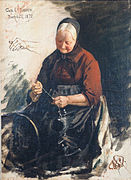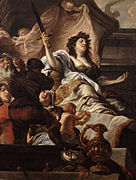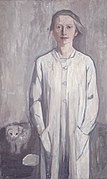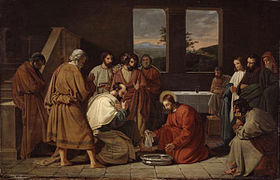Museumsberg Flensburg
 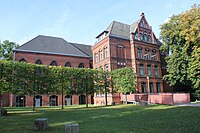 Heinrich Sauermann House (above) Hans Christiansen House (below) |
|
| Data | |
|---|---|
| place | Museumsberg 1 D-24937 Flensburg |
| Art | |
| opening | 1876 |
| operator |
City of Flensburg
|
| Website | |
| ISIL | DE-MUS-045414 |
The Museumsberg Flensburg with an exhibition area of 3,000 sqm of the largest museums in Schleswig-Holstein and provides a comprehensive insight into the art and cultural history in the Schleswig region of 13 to the 20th century and in contemporary art. On a hill above the city theater, embedded in a charming landscape, the two museum buildings Heinrich-Sauermann-Haus and Hans-Christiansen-Haus form a unit with the Old Cemetery and Christiansen Park .
history
The furniture maker and carver Heinrich Sauermann (1842–1904), who worked in Flensburg, sold his private collection of art and craft antiquities to the city of Flensburg in 1876 . This laid the foundation for the Flensburg Museum of Applied Arts , of which he also became the first director. The apprenticeship workshop attached there and founded by him quickly developed into the arts and crafts school , which already at the turn of the century enjoyed a reputation that reached far beyond the national borders. Even Emil Nolde been there students and applied later in vain for the local directorships. Together with the arts and crafts collection, the school moved into the museum building, which was inaugurated in 1903 and which is still today in all its splendor in the style of the Dutch Renaissance . The furniture collection founded by Heinrich Sauermann is still one of the most extensive of its kind in Germany.
Since 1999, the building on the ground floor has also housed the city's natural science museum (local history museum), which used to be located in a building with the Flensburg city library on Süderhofenden street . Some of the holdings in the natural science museum have also found a new place in the Ice Age House in Christiansenpark. Conversely, the foundation of today's Flensburg Maritime Museum , located at the harbor, grew out of the holdings of the Museumberg .
Even though the museum director and furniture manufacturer Heinrich Sauermann, as a man of the trade, never thought of building up a painting collection, but always focused on expanding the furniture and handicraft collection, there have been efforts since 1900 to promote contemporary painting in Flensburg. To this end, Sauermann in Flensburg received support from the Kunstgewerbeverein, which had existed since 1883 and which was expanded in 1903 to become an “Association for Art and Applied Arts”. In 1905 the museum received a first picture by a contemporary artist as a gift. As a successor to Sauermann, Fritz Fuglsang in particular , who succeeded Walter Heinrich Dammann (1921–26) acting museum director from 1927 to 1961, had done a lot to expand the hitherto relatively small collection of paintings. With the support of the new art association and the help of foundations , he systematically developed the holdings into a closed and high-quality regional collection. This work was continuously continued by his successors, so that the Museumsberg today has an outstanding picture gallery with a clear profile.
The painting collection only received a real appreciation for this work since 1997. After the painting stock had to be stored in storage due to a lack of space, the collection found a new home in May 1997 in the former school located directly next to the old museum building (Heinrich-Sauermann-Haus) . The former secondary school and agricultural school ( Goethe School Flensburg ), inaugurated in 1896 and built in a moderate neo-Gothic style, was named after the internationally renowned Art Nouveau artist Hans Christiansen , who was born in Flensburg (Hans Christiansen House) and has been converted into a modern museum. The painting collection of the old museum houses an exhibition area of 1500 square meters and offers additional space for changing exhibitions on the ground floor.
Overview of the site and the collections
Collection in the Heinrich Sauermann House
The Heinrich Sauermann House gives a comprehensive insight into the art and cultural history of the Schleswig region, and the Flensburg Natural Science Museum has been located there since 1999 . Even today, the cultural and historical tour is based on the concept of the museum's founder Sauermann and comprises 25 rooms on two floors with exhibits from Gothic to Biedermeier . As a special attraction here, among other things, farmhouse parlors from the 17th and 18th centuries, including the Döns and Pesel , mainly from the North Frisian Islands and Halligen , have been faithfully rebuilt and integrated into the premises. A St. Mary's altar from 1517 from the parish church in Hütten is also particularly impressive . There is also the Viöler Madonna , a high Gothic Madonna sculpture . Some of the holdings, including some of the furniture that used to be found in the Heinrich Sauermann House, can now be found in the Hans Christiansen House.
- Selection from the picture collection of the Heinrich Sauermann House
Due to the lack of space and the shift in the center of gravity, there are fewer exhibits relating to the history of the city to be found in the museum these days, so that this part is now basically limited to one room. There, for example, you can find the Kaakmann who was on the pillory of the city and warned. The executioner's sword is also on display. The portrait of Lütke's name hangs next to it in the room . Here and there a few other objects relevant to the history of the city can be found scattered around, for example the original of the unusual unicorn from the Rats-Apotheke, which looks over its own buttocks. It was built between 1745 and 1766. The Heinrich Sauermann House was completely refurbished and redesigned after a two-year closure. Since reopening, there have been regular solo exhibitions by contemporary artists in three spacious changing exhibition rooms on the 1st floor, some of which extend into the museum's collection rooms, where they relate to the existing exhibits (e.g. 2014 Daniel Spoeri, 2015 René Schoemakers ).
The Museumberg as seen from Fritz Wempner Platz (sometimes called Theaterplatz). (2015)
The Unicorn of the Council pharmacy on the spar in Flensburg city is the original from the 18th century in the Heinrich-Sauermann-Haus
The little lion is a cultural monument of the district . He comes from the Mürwiker Park with its museum .
Still picture Saved (1887) by Adolf Brütt in the museum's green spaces
Collection in the Hans Christiansen House
The Hans Christiansen House is a former school that was built in the neo-Gothic style between 1894 and 1896 . An extensive furniture collection founded by Heinrich Sauermann has been in the building since May 1997. The house also offers a large collection of paintings with works mainly by Schleswig-Holstein artists from the period of classicism to modern times . The focus is on the period of Art Nouveau (Hans Christiansen) and Expressionism . Works by Louis Gurlitt , Carl Ludwig Jessen , Hans Peter Feddersen , Jacob Nöbbe , Emil Nolde and Erich Heckel, among others, can be seen.
A special gem of the collection is located in the auditorium , which is equipped with large colored lancet windows and a carved beamed ceiling , on the 1st floor of the former school. It is the sumptuously designed "Low German Room" in the style of historicism , the so-called "Paris Room". Heinrich Sauermann made it in Paris held Universal Exposition in the year 1900's. The order was to show a living space with a "German character" with the most abundant furnishings. Sauermann was awarded a gold medal for this in Paris. Weddings also take place in the “Paris Room” today.
The temporary exhibition area is on the ground floor of the Hans Christiansen House. Regular solo exhibitions of contemporary art as well as exhibitions on art and cultural-historical topics take place there.
- Selection from the picture collection of the Hans Christiansen House
Old cemetery and Flensburg lion
The old cemetery, which is adjacent to the two main buildings of the museum, is now looked after by the museum. The cemetery was the first municipal cemetery in Schleswig-Holstein. It was inaugurated in 1813 and was used for funerals until 1954. Many of the graves from this period have been preserved.
After long negotiations about his return from Copenhagen , the Idstedt lion was re-erected on September 10, 2011 in the Old Cemetery. Prince Joachim of Denmark made the solemn unveiling . In November 2011, the accompanying exhibition Well roared, lion! Was held in the Hans Christiansen House . Neighborhood takes place around the Idstedt lion .
Christiansenpark and Ice Age House
The Christiansenpark adjacent to the Old Cemetery in the Westliche Höhe district is now looked after by the museum. The garden laid out in 1797 in the style of English landscape gardens by the Christiansen family was merged with the garden of the merchant Peter C. Stuhr in 1820 and thus extended over 25 hectares from the Nordergraben and Südergraben along the slopes to Marienallee. At the end of the 19th century, the city built various larger institutions on the eastern part of the site, including the museum, the court , the prison and schools. In 1992 the city of Flensburg bought the remaining part of today's 4.2 hectare Christiansen Park. In addition to nature, the special features of the park are the Ice Age house, which also houses some of the holdings of the natural science museum (local history museum), as well as the mummy grotto , which was created around 1800 and houses a Phoenician sarcophagus (around 400 BC) . The park area directly on the Museumsberg was originally created as an extension of the green spaces in Christiansenpark. There is the mirror grotto , completed in 1823 , which may have had a ritual function for Freemasonry .
Ice Age House in Winter 2012
More works of art
Justitia (approx. 1663–1665) by Jürgen Ovens
Portrait of the farmer Andreas Clausen (1821) by Christoffer Wilhelm Eckersberg
Italian Coastal Landscape (1844) by Louis Gurlitt
Children's bed (1924) by Wenzel Hablik
Self-portrait in a smock (1913–1914) by Käte Lassen
Washing of the feet (1831) by Detlev Conrad Blunck
Rape field on the Baltic Sea (1895) by Hans Olde
Maritime Museum
After the purchase of the customs warehouse on the former sailing ship pier in 1984, the ship-related museum holdings were relocated to the Flensburg Maritime Museum as a branch of the city museum.
See also
literature
- Malte Klein: The Flensburg Museum of Applied Arts Concept and functions of a museum in the German Empire . Kiel, 2007. ISBN 978-3-937719-68-9 .
Web links
- Museumsberg Flensburg
- Works by the artists of the Museumsberg
- Multimedia presentation about the Flensburg Museum of Applied Arts in the German Empire
Individual evidence
- ↑ http://www.kn-online.de/Schleswig-Holstein/Kulturszene/Ulrich-Schulte-Wuelwer-nnahm-seinen-Abschied-in-Flensburg
- ↑ http://www.shz.de/lokales/flensburger-tageblatt/85-jahre-kunstgeschichten-id8248796.html - http://www.museumsberg-flensburg.de/
- ↑ Uni Kiel: Heinrich Sauermann and the applied arts movement ( page no longer available , search in web archives ) Info: The link was automatically marked as defective. Please check the link according to the instructions and then remove this notice.
- ↑ Ludwig Rohling u. a .: Art monuments of the city of Flensburg. Munich 1955, page 550
- ↑ Official announcement on the development plan for the senior citizen center Swinemünder Straße ( Memento of the original from March 4, 2016 in the Internet Archive ) Info: The archive link was inserted automatically and has not yet been checked. Please check the original and archive link according to the instructions and then remove this notice. , Page 16, of: April 15, 2015; Retrieved on: December 19, 2015
- ↑ Museums Nord, Museumsberg Flensburg: Exhibition opening, September 9, 2011: Well roared, lion! Neighborhood around the Idstedt lion . ( Memento of the original from August 29, 2014 in the Internet Archive ) Info: The archive link was automatically inserted and not yet checked. Please check the original and archive link according to the instructions and then remove this notice.
- ^ Andreas Oeding, Broder Schwensen, Michael Sturm: Flexikon. 725 aha experiences from Flensburg! 1st edition. Office Oeding, Agency Sturm, Society for Flensburger Stadtarchiv e. V., Flensburg 2009, ISBN 978-3-925856-61-7 , Christiansenpark, p. 43 .
- ^ Andreas Oeding, Broder Schwensen, Michael Sturm: Flexikon. 725 aha experiences from Flensburg! Flensburg 2009, mirror grotto, p. 217-218 .
Coordinates: 54 ° 47 ′ 8.6 " N , 9 ° 25 ′ 53.7" E
















